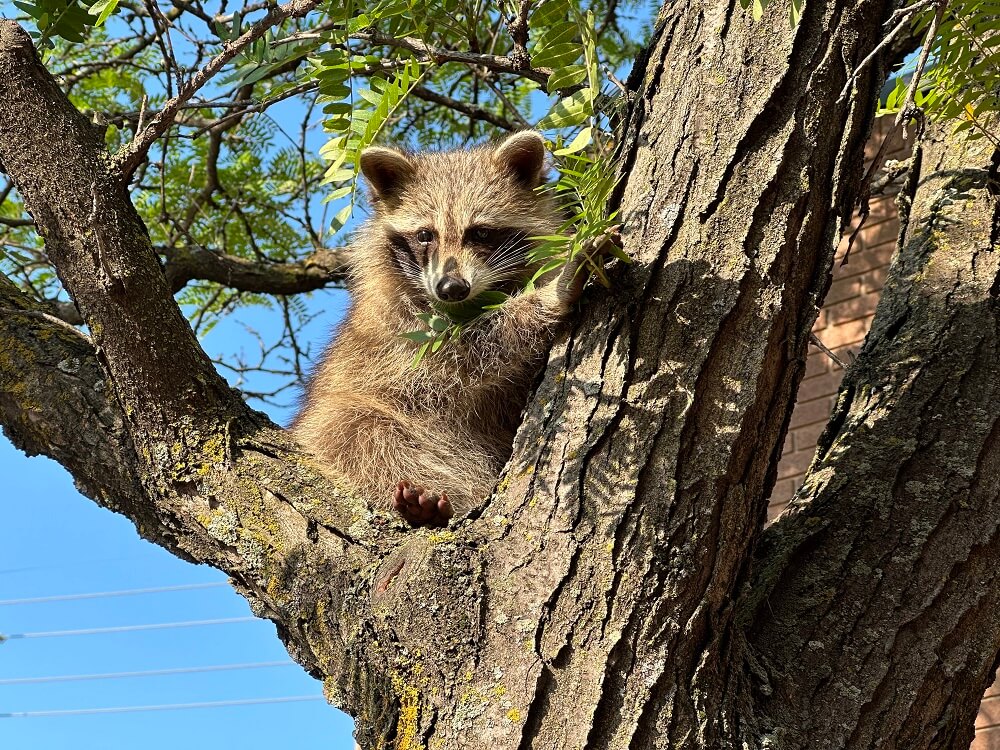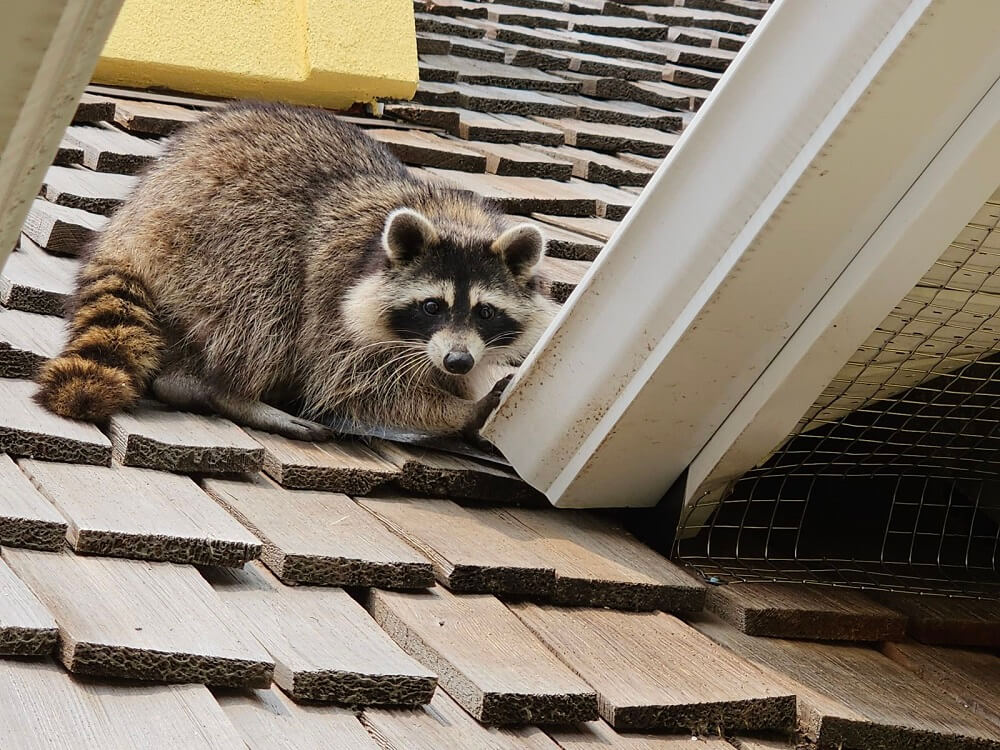RACCOON REMOVAL PROCESS
Assess and Remove
Raccoons are very intelligent and resourceful. This is why our 50 point inspection is designed to identify all current and potential raccoon entry points as well as any damage they may have caused. Our hands-on removal techniques are both humane and effective for adult and baby raccoons alike.
Clear and Clean
Raccoons are not very clean and their presence can lead to severe property damage. Skedaddle offers thorough cleaning and disinfecting of raccoon den sites to eliminate any health risks. We can also remove and replace any damaged attic insulation.
Prevent and Protect
Once the raccoons are gone you want to make sure your home is protected against future entries. Our wildlife technicians are experts in identifying and securing vulnerable areas of your home with exclusion materials that are built to last.
Raccoons are commonly seen in Anoka County, a region known for its abundant wildlife. These clever creatures, primarily active during the night, have adapted to urban environments and are often spotted rummaging through trash cans and foraging for sustenance in the form of leftovers or unattended pet food. Their resourcefulness in finding food sources allows them to thrive in even the most challenging circumstances. Sometimes raccoons find their way into attics and chimneys while searching for warm places to birth babies.
Recognizing the signs of a raccoon infestation allows you to know when to call an expert for wildlife removal in Anoka County. Skedaddle is here to help you with our raccoon removal services so that you don’t have to worry. We understand how overwhelming it might be when unwanted wildlife invades your space, but we will help you get rid of them quickly.

Raccoons Living in Anoka County
Many types of wildlife are driven out of the area as urban development expands. Raccoons, however, often thrive in suburban and urban environments as well as in dense forests. The animals are notorious scavengers and eat a varied diet consisting of everything from insects and rodents to leftover scraps in trash cans. Their insatiable appetites often lead them to residential properties where they can find easy sources of food.
Despite their initial appearance as cute, cuddly bandits, raccoons can be quite dangerous. It is important to maintain distance from them on your property due to their reputation for carrying rabies. Additionally, they can transmit hazardous diseases through their droppings. When raccoons feel threatened, they have been known to act aggressively.
Minneapolis is growing every year, and as a result home and business owners in Anoka County find raccoons living inside their property each year, as they are continually pushed out of their natural environments.. Areas like The Lakes, where an abundance of natural resources can be found, are home to thriving wildlife populations, including raccoons. However, as incredibly adaptable animals, raccoons often choose urban environments over their natural homes. In Anoka County communities, raccoons thrive on the convenience of large amounts of food sources and homes to find shelter.
Signs of a Raccoon Inside Your Home
Raccoons prefer to avoid direct interactions with humans, so if they enter your house in search of shelter, they usually take up residence in the hidden recesses of your home. Attics and chimneys make ideal places for a mother raccoon to den and keep her babies warm. Look for the following signs of a raccoon in your home so you can take quick action for removal if necessary:
- Squeaking noises from kits
- Claw marks around holes in the siding of your home
- Scurrying noises in the attic
Strategies for Deterring Raccoons
Most people do not have problems with raccoons living on their property as long as the animals stay away from the house. You can implement a few simple strategies to make your property a less appealing environment for raccoons so they move on in search of a more suitable home.
Eliminating food sources is one of the best ways to deter raccoons. Properly securing your garden, cleaning up pet food and latching trash can lids make it harder for raccoons to access food. If food is not readily available, the creatures are not likely to den nearby.
Because raccoons are nocturnal and only active at night, they do not like bright lights or loud noises. Installing motion-activated lights around your property is often enough to startle them, and increasing noise levels around the house can also be an effective deterrent.
Steps for Removing Raccoons Humanely
You may think that trapping raccoons and relocating them to a more suitable environment is the most humane method to get them out of your home. Unfortunately, this tactic causes unnecessary stress on the creatures and leads to injury and death in many cases.
To get raccoons out of your house without harming them, Skedaddle practices humane exclusion tactics. We want to remove raccoons without causing the creatures stress, and we take special care to avoid separating a mother from her babies for too long.
We first assess the situation. We need to know if there are babies involved as this information impacts our removal strategy.
The next step is to install one-way doors at the point of entry where the raccoons gain access to your home. These doors let raccoons leave your home in search of food, but they are unable to return when they are done hunting. The animals exit your home with no prompting from you, which allows for removal with no stress.
If there are babies in your house, we remove them by hand and put them in a reunification box. We put the box outside on your roof when the mother can easily find it and wait for her to reunite with her babies to ensure both parties are safe.
Finally, we board up any potential points of entry and give you tips on how to keep raccoons away from your home in the future. Exclusion tactics are often more effective than other removal methods.

Contact Skedaddle for Raccoon Removal in Anoka County
If you live in Anoka County, chances are you’ve had an encounter with a sneaky raccoon or two. These animals may look cute and harmless, but they can cause major damage to your property if left unchecked. From tearing up your garden to raiding your trash cans, raccoons can be a real nuisance. The good news? You don’t have to handle the problem alone.
Contact Skedaddle Humane Wildlife Control, your go-to for raccoon removal in Anoka County, and let our team of experts take care of the problem for you. Don’t let raccoons wreak havoc on your home and yard any longer, give us a call and enjoy some peace of mind.
Raccoon Facts
FACT:
Raccoons are highly adaptable to Anoka County’s growing urban landscape, and have been able to thrive in urban environments by raiding trash cans and feasting on human food. They’re particularly fond of sweet and fatty foods, which is why they’re often attracted to bird feeders and pet food bowls. The Minnesota DNR estimates that there are between 800,000 and 1,000,000 raccoons in the state.
FACT:
The black mask raccoons are famous for is more than just a distinctive pattern. The small black strip of fur helps raccoons to reduce the glare of lights, which allows them to navigate after nightfall better.
FACT:
Raccoons naturally den inside hollowed trees, fallen branches, and bushes. Minnesota’s forested landscape provides their natural denning locations for raccoons, however, they often prefer to den in urban areas that provide warm attics, chimneys and garages.
FACT:
Raccoons are one of the only mammals that can descend vertical surfaces head first. Their strong hands and long claws allows them to securely grip onto various surfaces and descend at a ninety degree angle. This skill allows raccoons to climb brick and siding materials on a home inorder to reach the roof.








